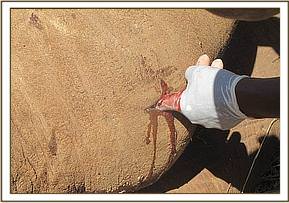Introduction Tsavo conservation area veterinary unit had a busy year in 2013 that is expected to remain the same this year
Introduction
Tsavo conservation area veterinary unit had a busy year in 2013 that is expected to remain the same this year. Wildlife conservation still remains challenging due to poaching threats and habitat destruction. The past months the region has received fairly good rains and the dry spell is expected to have minimal impact in the ecosystem especially on elephants and other wildlife nutrition. Elephant cases though minimal continue to account for a big percentage of units activities. While the unit staff was on leave, cases were attended by the skyvet initiative where Vets were flown in from Nairobi. In January an elephant bull had to be euthanized due to untreatable front limb injury. Bulls continue to bear the brunt of poaching attempts due to their huge tusks.
Case #1 Treatment of an injured elephant bull:
Date: 18th January 2014
Species: Elephant
Sex: Bull
Location: Makingu Area, Amboseli
GPS: 37MO308077
UTM9702571
History:
This is a clinical intervention of an injured elephant bull at Amboseli National Park. This case was attended through the Sky Vet initiative.
This is a repeat treatment after the first treatment at Oldare II area on 11th January 2014. The elephant had moved less than 10 Kilometers for 7 days and was living close to a water point.
Immobilization:
The injured elephant was found on lateral recumbence position on the ground; he was in pain and tried to relief pain by sprawling down. However, he was strong enough to rise up and walk way. Etorphine Hcl(0.98%) (M99®) (Norvatis South Africa (Pty) Ltd) 17mg, in a 3 ml Dan - inject dart was prepared.
Observations and Treatment:
An open wound about 15-20cm in diameter on the medial aspect on the left front leg at phalangial joints. The wound was deep enough such that the phalangial bones had been exposed and had deep seated pockets of pus. The wound was heavily contaminated and was suppurative. There was another wound located on the medial aspect of right front leg, mid area of the radius and ulna region. This wound was also purulent and had sharp edges. The wound was 5 cm wide and 5 cm deep. Some dead tissues were also excised. The wounds were cleaned with copious amounts of water to remove mud and dirt. The wound was also cleaned with normal saline and again liberally cleaned with Tincture of iodine. Oxytetracycline spray (Norbrook Laboratories Ireland) was also applied. The wounds were also covered with green clay to promote faster healing. The elephant was injected with the following, 1. High dose of Amoxicillin Trihydrate BP 60000mg by intramuscular route 2. Dexamethasone 80mg by intramuscular route
Prognosis: Poor prognosis as the phalangial or ankle joint is heavily inflamed and infected. The pyogenic wound is an open large wound exposing the phalangial bones and the joint is open and heavily contaminated.


Case #2 Management of an injured elephant bull:
Date: 26th January 2014
Species: Elephant
Sex: Male
Location: Ithumba AreA, Tsavo East
History:
The report was received of an elephant spotted limping badly and unable to move far. KWS and Sheldricks desnaring teams monitored the elephant until the vet team arrived. The elephant appeared traumatised and chased the teams who on attempted to dart him.
Immobilization and treatment:
The bull was immobilized by foot darting using 18 mgs of etorphine in a dan inject dart system. The elephant went down in a lateral recumbency and the team embarked on the treatment process. The body condition of the elephant was fair with wounds on the pressure points, an indication of struggling to wake after falling down. Close observation revealed a swollen infected joint within synovial membrane destruction on the ankle joint. Pus was oozing from the medial and lateral aspects of the foot. The suspected arrow wounds were given a poor prognosis of healing. With poor prognosis and the high threats from poaching in the area it was deemed appropriate to euthanize the elephant. Tusks were retrieved and the autopsy confirmed the diagnosis.




Conclusion:
Rains within Tsavo conservation area continue to receive good rains that come as a blessing to wildlife in terms of water and forage availability. The rains are expected to continue falling during the month of February. Cases are also expected to remain low. The unit acknowledges the support of its sponsors ViER PFOTEN through the David Sheldrick Wildlife Trust (DSWT) for their great support to the unit and not forgetting the Kenya Wildlife Service (KWS). Report by: Dr Jeremiah Poghon